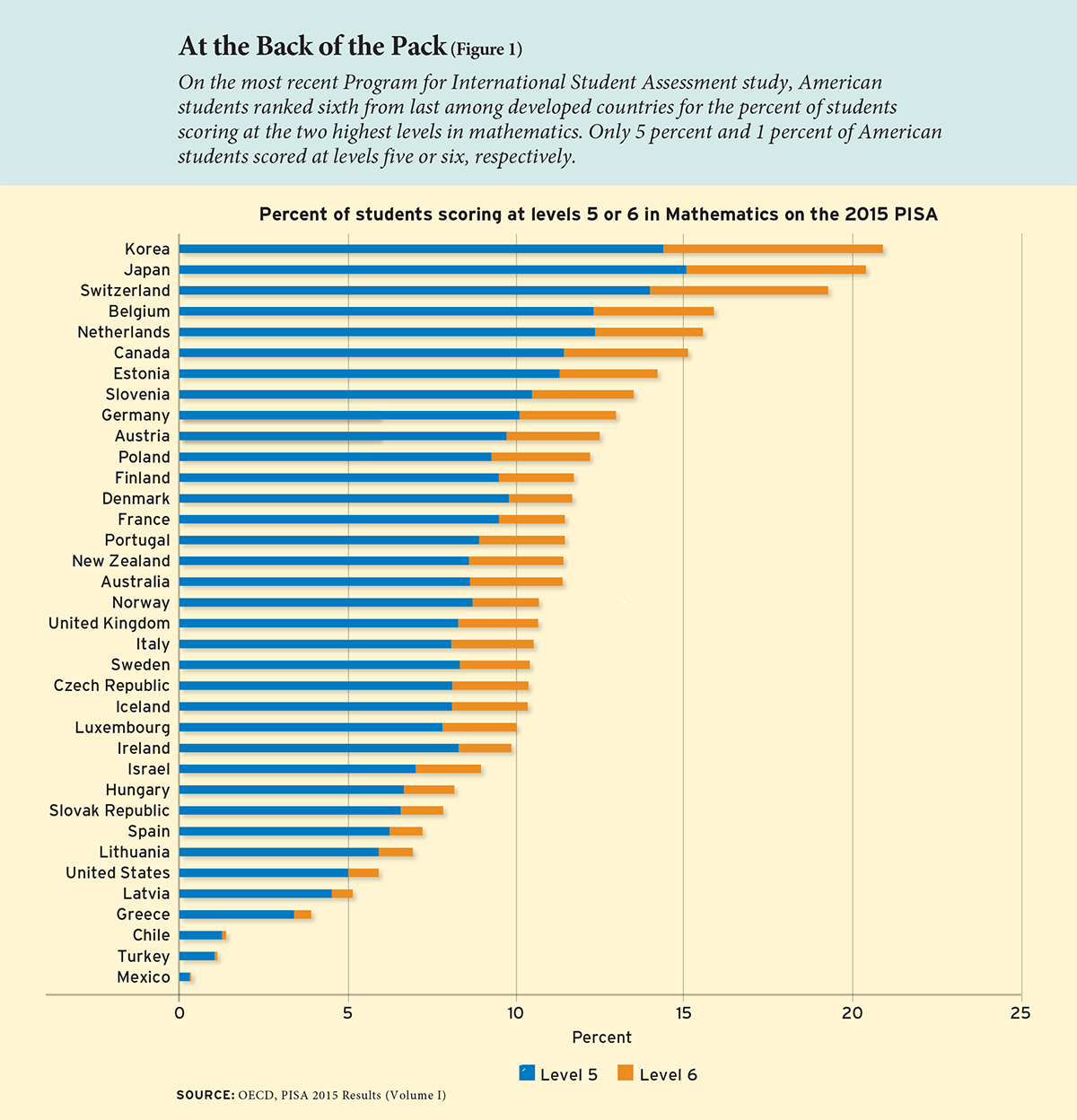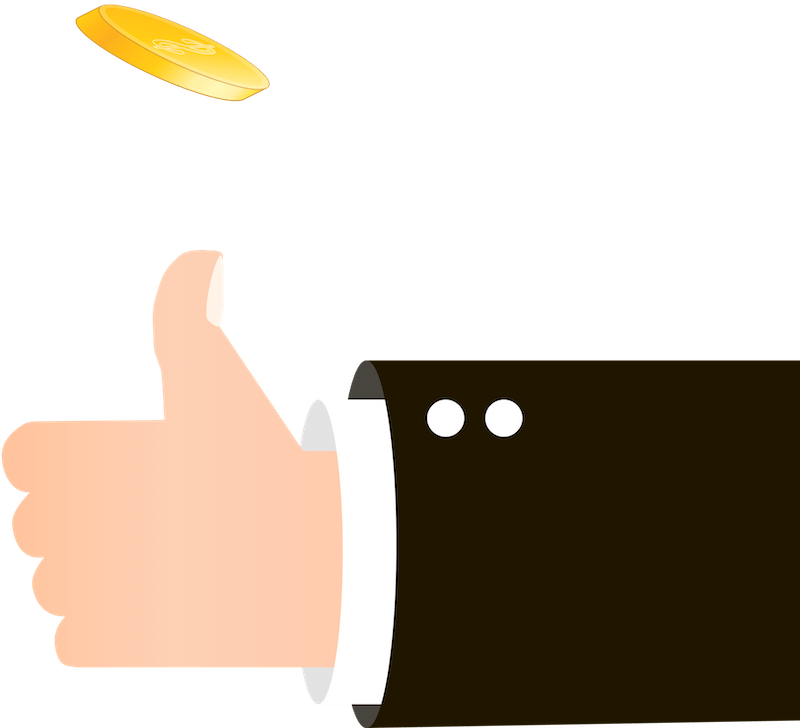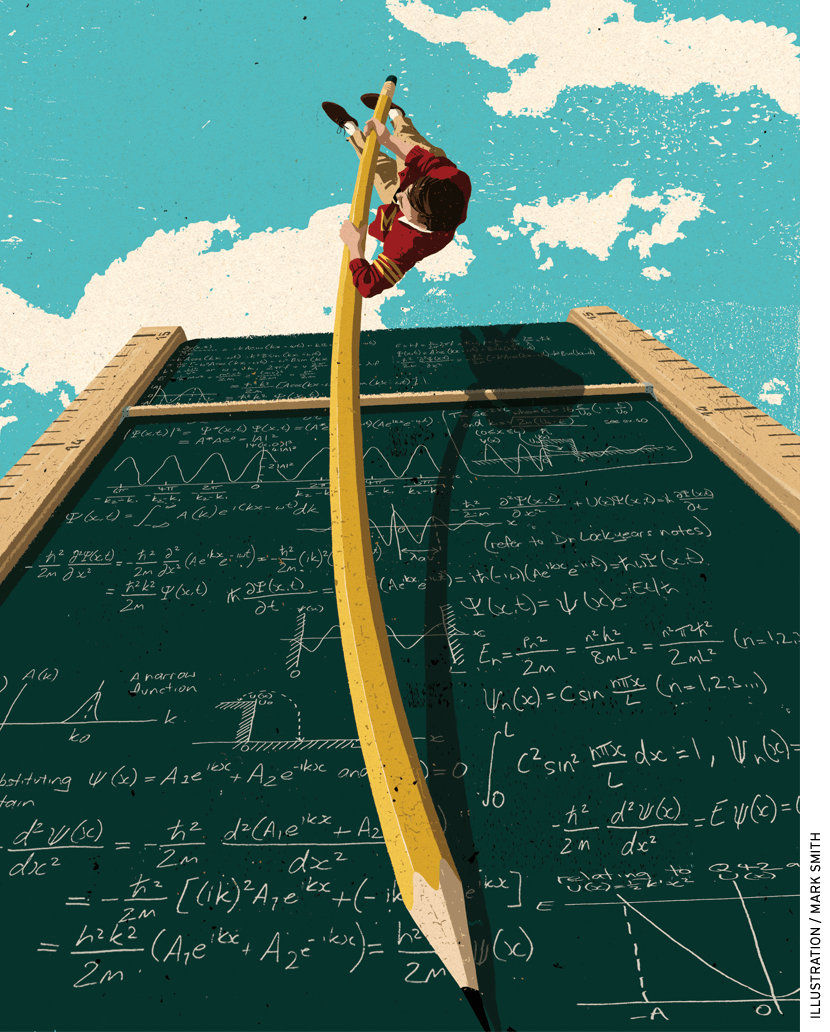 Megan Joshi has always loved math— and excelled at it. When she was seven, her parents would reward her for doing chores around the house with algebra and geometry workbooks. Joshi capped her senior year in high school by winning the Math Prize for Girls, an annual competition for high-schoolers from the United States and Canada, and earning a silver medal at the European Girls’ Mathematical Olympiad.
Megan Joshi has always loved math— and excelled at it. When she was seven, her parents would reward her for doing chores around the house with algebra and geometry workbooks. Joshi capped her senior year in high school by winning the Math Prize for Girls, an annual competition for high-schoolers from the United States and Canada, and earning a silver medal at the European Girls’ Mathematical Olympiad.
Even though Joshi grew up in a wealthy Southern California community, her public schools played little role in these achievements or in nurturing her passion for math. In elementary school, she was a standout. As a 3rd grader, she was placed in 5th-grade math and still outperformed the other students. She found ways to keep herself “less bored” by helping classmates, grading papers for the teacher, and, when there was nothing else to do, reading novels. “I don’t especially remember paying attention,” said Joshi, now an undergraduate at Massachusetts Institute of Technology.
Tens of thousands of students languish in similar mathematical monotony in schools that are unable to fully support them. Despite the overall limp scores of U.S. students on state, national, and international math exams, the number of high-achieving math students in the country has soared during the past 20 years. During those two decades, the number of schools offering Advanced Placement classes in Calculus AB and Calculus BC grew by about 50 percent. The number of students taking those courses jumped to nearly half a million—an increase of 161 percent—and pass rates are rising. In 2018, twice as many 8th graders and 50 percent more 4th graders scored as advanced in math on the National Assessment of Educational Progress, as compared to their counterparts in the year 2000.
A 2017 study in the journal Gifted Child Quarterly found that between 16 percent and 37 percent of students in California, Texas, and Wisconsin scored at least one grade level ahead in math—and as many as four—on state standardized exams.
In the years since Congress passed the No Child Left Behind Act of 2001, which held schools accountable for each student’s proficiency in core academic subjects, policymakers and educators have put significant effort into getting all students up to minimum standards. But there is no comparable effort to meet the unique needs of the nation’s highly gifted math students in the public schools.
“The country needs to develop talented, visionary problem solvers,” said Jonathan Plucker, an education professor at Johns Hopkins University and president-elect of the National Association for Gifted Children, “yet we’re not finding ways to get enough of that talent,” especially among low-income and traditionally underserved students. “We have a very diverse student population that gets more and more diverse every year; those are a lot of talented kids that are totally sidelined.”
Global competitiveness and the U.S. workplace increasingly require skills in science, technology, engineering, and math, known collectively as STEM. The U.S. Bureau of Labor Statistics projects more than 5 million new STEM jobs by 2024, with the largest growth rate expected in mathematical-science occupations. Yet, of all the 2018 U.S. high-school graduates headed to college, only 20 percent were prepared for college-level STEM work, according to college entrance-exam developer ACT.
Data from the Program for International Student Assessment reveal that, by the time U.S. kids are 15, the nation ranks sixth from last in the share of students achieving at an elite level (see Figure 1). But the deficit begins earlier than that. American 4th- and 8th-graders fall below Singapore, South Korea, Russia, Northern Ireland, England, and other developed nations in math achievement, based on scores from the competency exam Trends in International Mathematics and Science Study.
While U.S. public schools are falling short in serving high-achieving math students, several programs in the private sector have stepped up to meet their needs. Art of Problem Solving, or AoPS, Math Circles, Mathcounts, the Center for Talented Youth, and Math Kangaroo are among the best-known private math-enrichment programs. These are not the ubiquitous tutoring centers that dot strip malls; they are online and in-person courses designed for students who thrive on the challenge of mathematical puzzles and need a welcoming community of kindred spirits they can’t find at school.
The programs—minus Math Circles, which doesn’t track student numbers nationally—enroll nearly 125,000 students annually. Another 350,000 people worldwide are registered with Art of Problem Solving’s free online community that lets kids share math problems and hosts forums and study groups on everything from Euclidean geometry in mathematics Olympiads to lighter fare about the latest movies.
But there’s a drawback to the approach: the students in the courses are overwhelmingly white, affluent, and male. Educators and advocates have begun to develop ways to extend these enrichment opportunities to the gifted students on the sidelines, but there’s a long way to go.
Programs for Math Whiz Kids
Sitting alone at a corner table in his neighborhood coffee shop in Menlo Park, California, Joshua Zucker leaned toward his laptop and typed, “Welcome to week 16, our final week together.”
“I love math,” responded a student with the user name Mat-h-ero.
“Math is amazing,” wrote another.
During the next 75 minutes, Zucker taught pre-algebra to about 50 students—in this particular course, about evenly split between girls and boys, hailing from all 50 states, and ranging in age from 8 to 12—through an online course developed by Art of Problem Solving. AoPS is a for-profit company that offers in-person and online courses for high-ability math students. It is accredited by the Western Association of Schools and Colleges commission.
The week’s topic was conversions, and Zucker started the class with a straightforward problem to assess the students’ understanding of the concept: If a car is traveling 64 mph for four hours, how far will it go? The students typed in their answers and nearly everyone got it right.
The problems became successively more difficult and required students to convert units, say hours to minutes, or to solve for speed instead of distance. For example: A police officer is chasing a bank robber on foot. The officer runs 12 miles per hour, while the robber runs 10 miles per hour. If the robber starts with a 1/10-mile lead, how long will it take the officer to catch him?
“Let’s think about this problem,” Zucker typed to his online students. “Is it asking us to solve for a distance, a time, or a speed? This is the same equation we already know expressed in a different way” (see sidebar).
There is no audio or video, just a screen on which Zucker deftly multitasks: posting problems, offering hints and explanations, and directing remote teaching assistants to work with students requiring more attention.
Since 2007, Zucker has taught more than 50 AoPS online courses. Before that, he taught high-school math, cofounded a math festival, and also started the San Jose Math Circle, part of a network of afterschool and weekend enrichment programs. Zucker has always loved math and wishes programs like AoPS existed when he was growing up. Although he was on the high-school math team, none of the students were at his level, said Zucker. “I was very isolated. There wasn’t anyone to bounce ideas back and forth. It was just me and some books sitting in my room by myself.”
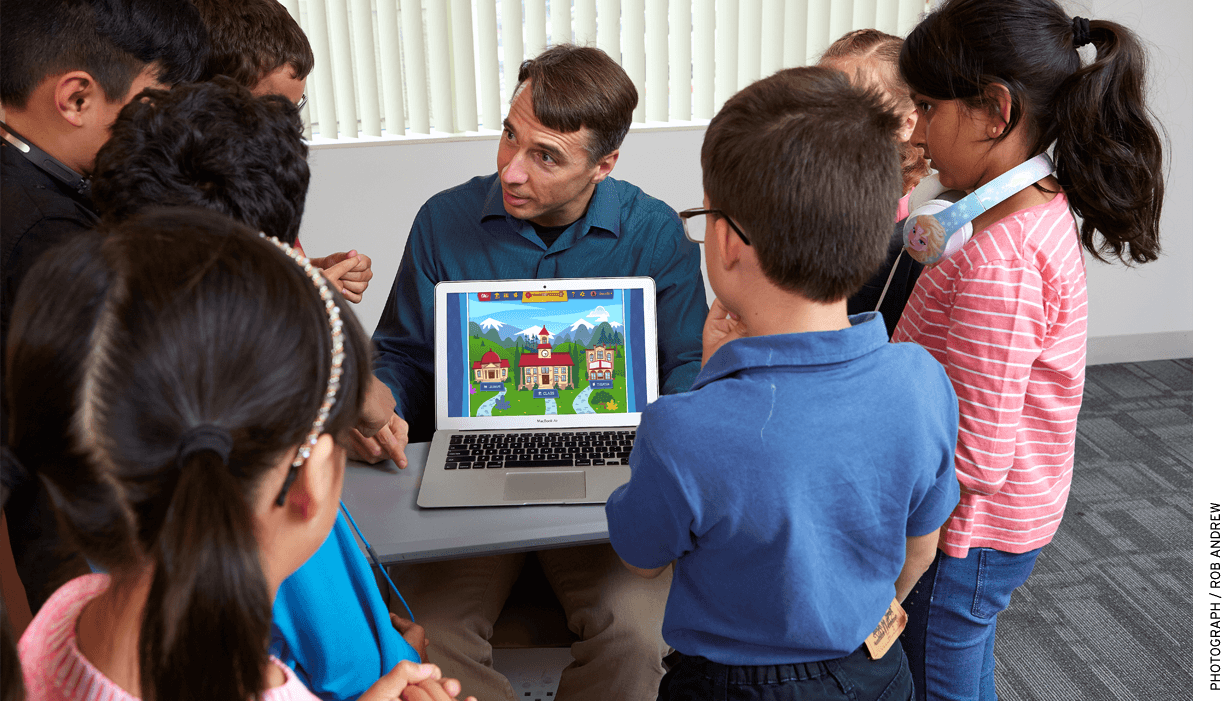
Richard Rusczyk also remembers that feeling, but he was fortunate that a teacher told his parents about Mathcounts, a nonprofit that runs the largest middle-school math competition in the country. That was the first time he met other kids like himself. Years later, after serving as an alternate to the 1989 U.S. team to the International Mathematical Olympiad, graduating from Princeton, and making brief forays into teaching and bond trading, he created an online community for math geeks, a term he proudly wears himself. In 2003, he founded AoPS. It’s a “bootstrapped” organization, said Rusczyk. He and his wife used their personal savings to launch AoPS and still own a majority stake. Nearly all other shareholders are employees. While he won’t disclose revenue figures, Rusczyk said AoPS has “been profitable for over a decade.”
In the beginning, it offered two online summer courses that enrolled a total of 24 students, and an online forum that drew several hundred students to share and discuss difficult math problems and chat. Today, the program runs 200 online courses a year, attracting nearly 15,000 students internationally. AoPS opened its first brick-and-mortar classrooms in North Carolina and Virginia in 2016 and has since added centers in Maryland, Washington, California, New Jersey, Georgia, and Texas. Together, they serve 4,200 students in grades 2 through 12. Several more sites are scheduled to open this year.
Rusczyk attributes the company’s success to staying true to the mission of designing a place where young people can do interesting, challenging math. “I’d say the guiding light for a lot of what we do is building the things that we wish we had when we were kids.”
Math Circles have also taken off, growing to at least 100 circles in 39 states. Each is independent, so it’s not known how many students participate nationwide, but many of them have substantial waiting lists.
The last place most teenagers want to be on a Friday night is in another math class. But 28 of them have gathered in a classroom of the math and statistics department at San Jose State University, giddily bent on beating their instructor, Alon Amit, at a game of probability, otherwise known as cheating by calculating. Well, not actual cheating. Amit is giving them a lesson on hustlers’ odds using a coin toss and math.
“Guys, here’s something absolutely mind-blowing. Instead of flipping coins until we find a pattern, we’re going to be playing a game,” he said, and explained the strategy carnies use to win at so-called games of chance.
“Now, because I’m in a generous mood today, I’m going to let you pick the pattern first,” Amit continued. “Which pattern do you want?”
“Heads, tails, tails,” they shouted. He picks heads, heads, tails and demonstrates how probability is on his side (see sidebar).
By day, Amit is vice president of products at Origami Logic, a marketing analytics and data startup that he cofounded. But the San Jose Math Circle is his first love.
“For many kids, the math program is the highlight of their week,” Amit said. “You can see this in their eyes. They come in here and they’re over the moon.”
That’s true for Jeremy Pettitt, 18, who plans to major in computer science at college. Pettitt is home schooled by his mother but outstripped her math ability and is learning calculus on his own by reading textbooks. He began coming to the San Jose Math Circle about three years ago.
“It’s really nice, because I don’t have to be the only one supplying ideas. If there’s something I’m not getting, I can turn and ask, ‘hey, am I doing this right?’” Pettitt said. “It’s nice being among my peers.”
Three of Amit’s students have won gold medals in the International Mathematical Olympiad and several have earned PhDs in math. AoPS students have had similar triumphs. In 2015, the United States won the International Mathematical Olympiad for the first time in 21 years, and followed with two more first-place triumphs in 2016 and 2018. All 16 students on those teams had enrolled in more than 100 AoPS classes, collectively. The six students on this year’s team have collectively taken more than 50 classes.
|
Cops and Robbers
The cop-and-robber problem is asking students to solve for time (t), specifically, how long it will take the officer to catch the robber. The equation is formed from the distance the officer travels, 12t (miles per hour multiplied by t) being equal to the robber’s head start of 1/10 mile plus the robber’s distance traveled, 10t: 12t = 1/10 + 10t Subtract 10t from both sides to simplify: 2t = 1/10 Divide both sides by 2 to find t: t = 1/20 of an hour, or 3 minutes for the officer to catch the robber Students often get sidetracked looking for total distance traveled, which isn’t necessary, said Joshua Zucker. To solve this problem, we only need to know how fast the officer is narrowing the gap. When students master the idea of relative rates, Zucker will give the problem another twist. For instance: What if they were running toward each other? How long would it take for them to collide? The value of learning new tools and strategies is that students can group several steps into a single chunk that’s easier for them to remember and use. This is important when moving on to more difficult problems, said Zucker. He believes it’s one of the reasons that people hit the wall in their math studies: “They’ve dealt with everything up to then by memorizing procedural steps instead of building understanding and building up better tools for handling the problem, and they become overwhelmed by all the things they have to keep in their head at once.” |
The Power of Problem Solving
Competitions aren’t for everyone, but just taking part in the practice sessions can bolster students’ problem-solving skills.
Kasia Kim, a 6th grader in Alameda, California, spends her Monday evenings during the school year at the University of California, Berkeley, taking classes through Math Taught the Right Way. The program’s approach offers a sharp contrast to what happens in school, she says, where teachers say, “OK, here’s this topic, here’s the formula, we’re going to make you do this for like, three months. Then they have a quiz on it, and then move on.”
Building a creative, analytic math muscle in kids requires that the subject matter be taught slowly, with each lesson building on the previous one, said Zvezdelina Stankova, a Berkeley math professor and director of Math Taught the Right Way. “It’s like learning how to play the piano,” she explained. “You cannot in one year learn what you should learn in six.”
Stankova based the program’s curriculum on the Bulgarian math she learned growing up in the former Soviet Union—a method she also used when coaching the U.S. team to the International Mathematical Olympiad. (She herself competed twice at the Olympiad on the Bulgarian team, winning two silver medals.) Math Taught the Right Way grew out of the Berkeley Math Circle, which Stankova cofounded in 1998. Math Taught the Right Way runs four sequences of courses a semester for students in grades 6 through 9; courses fill up quickly and there is always a waiting list.
Students must show and explain every step of their work—listing the variables, drawing a picture or diagram, identifying the technique used, and then explaining other situations in which that technique would work.
Elysee Wilson-Egolf, a teacher at Math Taught the Right Way, calls this the “struggle strategy” that every student needs to develop, one “that allows them to try problems in new contexts, to apply the things that they know in different scenarios.”
The strategy isn’t just useful in math but in all subjects and all arenas of life. The essence of mathematics is being able “to solve a problem that nobody told you how to solve,” said Stankova’s colleague Tatiana Shubin, who cofounded the San Jose Math Circle and is a math professor at San Jose State University. “I don’t believe that everyone in their adulthood needs to know how to factor a quadratic expression, but everyone needs to be able to confront difficult problems without fear and just fight those problems with the power of their own mind.”
Addressing the Equity Gaps
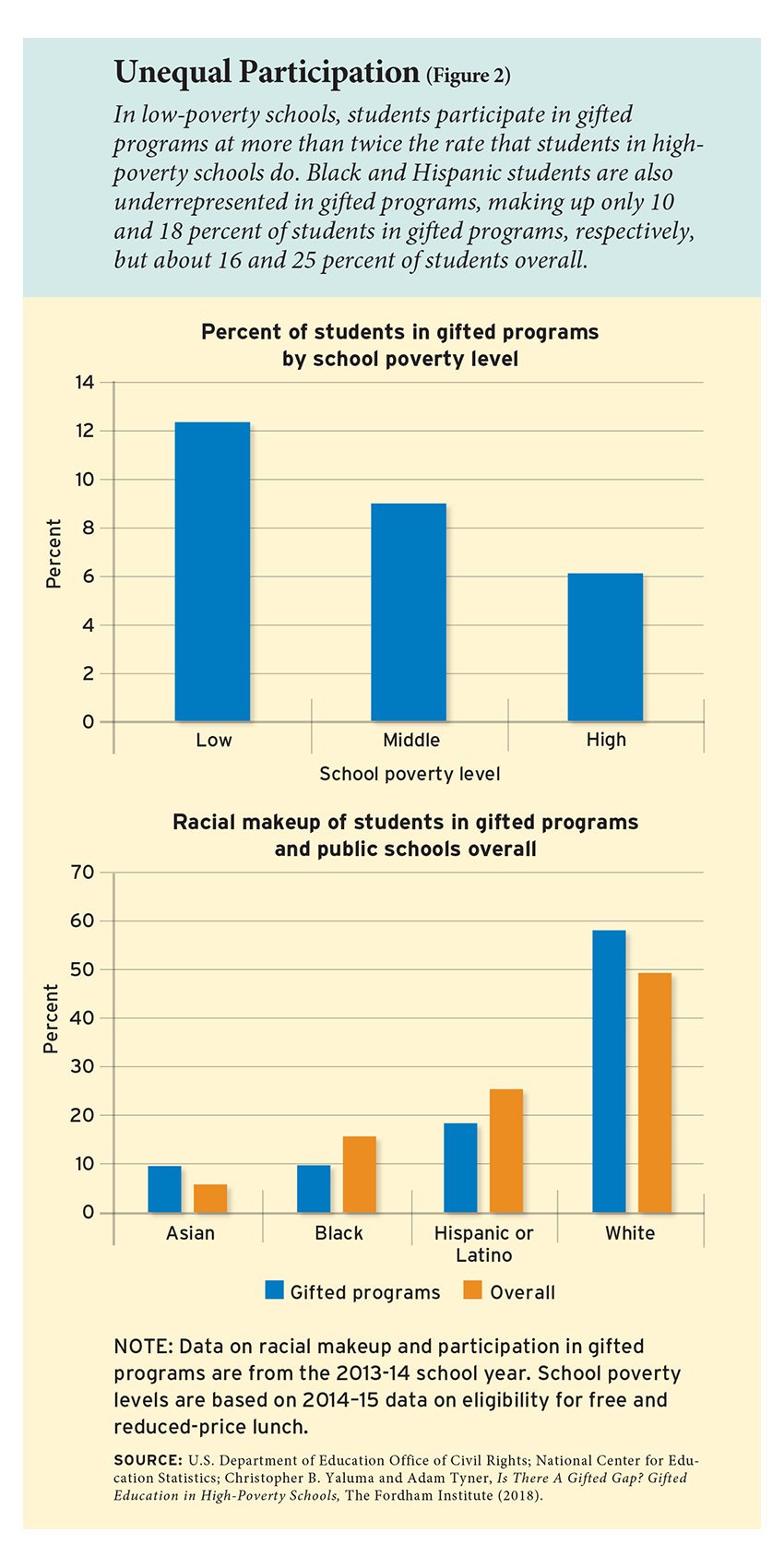 Families in middle-class and affluent communities learn about private math-enrichment programs from teachers, on neighborhood listservs, and by word of mouth. But word may never reach families in underserved schools and communities and, even if it does, impediments abound. The programs are expensive, often have limited space and, at the higher end, require entrance exams that favor students in wealthier schools with well-educated parents.
Families in middle-class and affluent communities learn about private math-enrichment programs from teachers, on neighborhood listservs, and by word of mouth. But word may never reach families in underserved schools and communities and, even if it does, impediments abound. The programs are expensive, often have limited space and, at the higher end, require entrance exams that favor students in wealthier schools with well-educated parents.
Similarly, public-school offerings for students of high potential do not reach all groups equally. Nearly 70 percent of public elementary and middle schools offer gifted and talented programs and, except for schools serving nearly 100 percent students of color, such programs are evenly spread among high- and low-wealth schools, according to a study by the Thomas B. Fordham Institute. However, students in low-wealth schools are less than half as likely to participate in a gifted program than their counterparts at high-wealth schools (see Figure 2). Likewise, about 90 percent of students attend schools with Advanced Placement courses, but the Education Trust found that schools less likely to offer AP tend to be those in high-poverty and rural areas.
Enrollment in advanced math courses shows an even wider gap by race, ethnicity, and income. The College Board, which administers AP exams, reports that despite a steady increase in the number of schools offering AP courses in calculus, more than half the students taking the Calculus AB exams are white. This is not particularly surprising, since white students make up nearly half (about 45 percent) of the K–12 population. But by contrast, only about 5 percent of the students who took the exam in 2018 were black, even though black students represent about 16 percent of the K–12 population.
American girls now outpace boys in academic achievement, even in math, but they remain underrepresented in high-end math programs. In the 44 years that the United States has participated in the International Mathematical Olympiad, only three girls have been selected for the team. Megan Joshi noticed the gender gap at the Mathematical Olympiad Summer Program, the training camp for international competitions. One summer, she counted just 12 girls out of 54 students participating. That inspired Joshi, who had just completed her freshman year in high school, to start the STEM for Girls group at her former middle school. Four years later, it’s still going strong, taking girls on field trips to local STEM companies and introducing them to successful women in STEM.
A smattering of nonprofits are aimed at closing these gaps, especially those related to income, race, and ethnicity. New York Edge runs free afterschool and summer programs in academics, athletics, and the arts for low-income students in New York City. In addition to starting the San Jose Math Circle—which is fee-based but offers scholarships—Tatiana Shubin also founded Navajo Math Circles in 2012, and trains teachers on the reservation to run them in their schools.
One of the largest outreach programs is Bridge to Enter Advanced Mathematics. Located in New York City and Los Angeles, the program is run by the AoPS Initiative, Inc., an independent nonprofit launched by Art of Problem Solving to address the income gap in math achievement. Bridge to Enter Advanced Mathematics partners with 35 schools in New York and 14 in Los Angeles, where at least 75 percent of the students are eligible for free or reduced-price lunch.
“The kids who are not connected are getting farther and farther behind, and we’re responsible for part of that gap,” said Rusczyk. “So, we felt a responsibility to try to reach, try to educate, try to serve, try to bring into this community people who wouldn’t naturally find it, people who don’t have parents who were engineers or scientists, people who don’t already go to schools that have math teams [and] math clubs.”
One Saturday in Greenwich Village, nearly 200 high-ability math students in the 8th through the 11th grade have come to New York University to participate in classes offered by Bridge to Enter Advanced Mathematics. Eighth graders take algebra and a high-school preparation course called “Things You Need to Know.” One of the program’s goals is for these kids to meet the competitive academic standards for admission to one of the city’s top-tier public high schools.
Youmna Nasr, 13, a first-generation American whose family emigrated from Egypt, took the high-school entrance exam and will be attending Bard High School Early College Queens, where students graduate with both a high-school diploma and an associate degree. Other 8th-grade students in the Bridge to Enter Advanced Mathematics program were admitted to highly selective New York City high schools, including Stuyvesant, Bronx Science, Brooklyn Technical, Manhattan Center for Science and Mathematics, and LaGuardia High School of Music & Art and Performing Arts.
Diversity is a pillar of Bridge to Enter Advanced Mathematics. Students are evenly split by gender, 56 percent identify as Latino or Hispanic, 39 percent as African American, 14 percent as white, 9 percent as Asian American, and 1 percent each as Native American or Alaskan Native and Native Hawaiian or other Pacific Islander. The median family income is $31,000; more than two thirds of students are eligible for federally subsidized school lunch.
Nasr likes that Bridge to Enter Advanced Mathematics supports students through the entire process, with test preparation for the Specialized High School Admissions Test; essay-writing workshops for the schools that require them; and counselors available in person, by text and through e-mail.
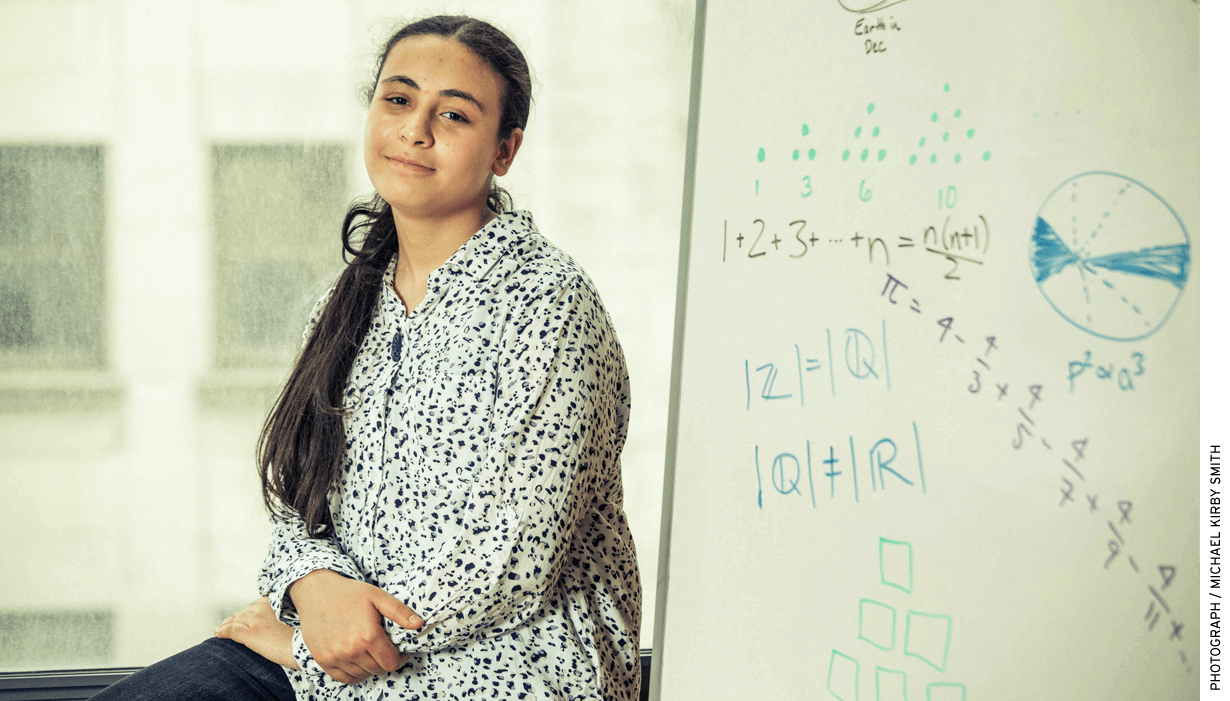
High-school juniors and seniors receive similar assistance for their college applications. Students also have access to emotional, financial, and social supports. The program serves lunch, provides eyeglasses for students who can’t afford them, and has a social worker available.
The heart of Bridge to Enter Advanced Mathematics is its summer program for students entering 6th and 7th grade. Staff members help teachers identify students who are likely to prosper in the program—not just those who excel at math, said Lynn Cartwright-Punnett, senior director of programs for Bridge to Enter Advanced Mathematics, but also those who enjoy solving problems and persist in the face of challenge. She tells teachers to look for students who are bored and get As with little effort, and asks them to keep in mind that “the strongest student in your room is lonely.” Sometimes such students are ostracized.
“In middle school everyone thought I was a little bit weird, since I liked math so much, so I was singled out,” said 15-year-old Agata Regula, who credits her immigrant parents with encouraging and helping her to succeed. In Bridge to Enter Advanced Mathematics, though, she encountered lots of other kids who “had a thing for math.”
Her involvement in the program served her well. When Regula entered Stuyvesant High School, one of the highest-ranked public schools in the city, she felt that she “had to play a little bit of catch-up,” but that participating in Bridge to Enter Advanced Mathematics gave her the confidence to persevere. Without it, she said, “it would have been so much worse. It would have been truly horrible.”
In Maryland, AoPS has a partnership with the Montgomery Blair High School Magnet Foundation, Inc., to run a pilot program called the Pipeline Project. This initiative places strong math students from low-income families into the Gaithersburg AoPS center’s Beast Academy, its program for kids in 3rd through 5th grade.
The nonprofit foundation was created in 2008 to raise funds for the science, mathematics, and computer-science magnet program at Montgomery Blair High School in Silver Spring after it was hit with budget cuts. The foundation selected 40 public-school students in Montgomery County—based on interest, grades, and teacher recommendations—to attend Beast Academy, and covered most or all of the $150-per-month tuition.
AoPS separated 3rd-grade Pipeline students from the other Beast Academy students to get them up to speed. This year, in 4th grade, they’re intermingled, and Pipeline students are doing so well the teachers have no idea who’s who, said Kelcie Bartley, the AoPS Academy national director of outreach.
The goal is to intervene while talented students are still in elementary school to put them on the advanced math track through high school. A key measure of its success will be how many Pipeline students are admitted to the highly selective math, science, and computer-science magnet program at Montgomery County’s Takoma Park Middle School, said computer-science teacher Samir Paul, a foundation board member and driving force behind the program.
In 2017, under 16 percent of the 860 5th-grade students who applied for admission to the Takoma Park magnet program were accepted. Only 15 of the accepted students were Hispanic, fewer than 10 were black, and boys outnumbered girls by almost two to one.
This imbalance becomes self-perpetuating because the Takoma Park magnet is the primary feeder program for the Montgomery Blair High School magnet program.
In an effort to counter the inequity, Montgomery County Public Schools revised the application process. Instead of leaving it to parents and teachers to refer students, the district automatically reviewed the education records of the entire 5th-grade class and notified parents of every student performing above grade level that, unless the parents objected, their children would sit for the magnet entrance exam. The selection process quadrupled the number of students in the 2018 application pool. It nearly closed the male-to-female gap, but there was a barely a blip in the number of black students selected, and admission for Hispanic students fell.
The change didn’t achieve the district’s goals of increasing minority-student participation in the magnet program because students were still selected on test performance, and high-stakes tests often undercut students who haven’t had the opportunity to attend high-performing elite schools. The district is again working to alter the selection criteria for the middle-school magnet program to make the application process less dependent on a standardized test.
The Center for Talented Youth at Johns Hopkins University has already been tackling this issue. The idea for the center began in the late 1970s with a Johns Hopkins psychology professor and one 7th grader from Baltimore who had taken every math class his school offered. Today, the nonprofit academic center runs summer, online, and family programs for gifted and talented students in grades 2 to 12 from around the world.
Typically, 75 to 85 percent of students who take the center’s verbal and math screening exams score high enough to qualify for its enrichment programs. But when the organization sought to create a program specifically for under-resourced Baltimore City Public Schools, only about 30 percent of students met the cutoff.
Amy Shelton, director of research and interim executive director of the program, thought it implausible that Baltimore students truly fell short on aptitude, so the center developed a research project to test other skills and abilities that predict success in math, such as spatial and working-memory ability and critical and divergent thinking. That began the Baltimore Emerging Scholars initiative for the brightest students in 16 of the district’s lowest-performing elementary schools. By the end of the 25-week curriculum, the “emerging scholars” matched students from wealthier schools in qualifying for the center’s regular programs. (A $300,000 endowment, bankrolled by gifts and grants, funds the Emerging Scholars program; another $5 million annually, from tuition and philanthropy, goes toward financial aid for students in the center’s other programs.)
Initially, when the center asked Baltimore schools to identify students for the Emerging Scholars program, it ran into pervasive bias, said Plucker, the Hopkins education professor, who is affiliated with the center. Teachers and principals were intrigued but told him, “We don’t have any gifted students here because we’re a mostly black, Hispanic, or low-income school.”
Plucker said such bias is common in schools, even among people who truly want these students to succeed. To try to counter it, he supports broader universal screening for gifted and talented programs and assessing students within the context of their school rather than the entire district.
“What we find is that if you skip the nomination phase and you just assess everybody, you find many more low-income students who are already performing at higher levels,” Plucker said.
Gadsden Elementary School District in southwest Arizona provides a small but powerful example of how schools can identify and nurture talented students who might otherwise fall through the cracks. The poor, rural district on the Mexican border serves 100 percent minority students, mostly Hispanic, and nearly every student is eligible for free or reduced-price lunch. Yet more students from Gadsden qualify for the Hopkins center’s summer programs than from any other district in the country.
When the district started a gifted program 13 years ago, it reviewed data for every student in grades 2 through 4, expanded tutoring in math and science, created a partnership with the local community college for high-performing middle-school students, and redesigned its professional-development programs for teachers. Counselors and teachers regularly communicate with parents, generally in Spanish, and help them fill out applications for enrichment programs. In other words, the district does everything possible to identify strong math students and develop their skills over the long term.
|
Winning at Heads and Tails
It may seem that flipping a coin is fair; after all, there’s a 50-50 chance of getting heads or tails on each flip. But if the game calls for a specific pattern of heads and tails to emerge in continuous succession over a series of flips, math strategy matters. Let’s say that Sansa and Bran agree to flip a coin for the Iron Throne. Sansa predicts that three heads in a row (HHH) will emerge first, while Bran selects tails, heads, heads (THH) as his pattern. If the first three flips are HHH, then Sansa wins, but if tails comes up in any of the first three flips, she has no chance of winning. Why? “Because once we have a T, we can never get three heads in a row without there being a T beforehand,” explains Alon Amit, a teacher at the San Jose Math Circle. “We get THH before the HHH pattern has a chance to show up.” Sansa’s chances of winning the throne are 12.5 percent, but Bran will win about 87.5 percent of the time. Bran decides to give Sansa another chance. Since tails, heads, heads (THH) worked so well for Bran, Sansa picks that pattern in the next round. Bran then picks tails, tails, heads (TTH) and, again, is more likely to succeed. The reason is this: both of them need to wait for a T to show up because both patterns start with a T. Once the first T comes up, the next two flips may be any one of these four combinations: • HH: Sansa wins with THH. • HT: The sequence is now THT, so neither player wins. The final T becomes the beginning of the chain, and they have to wait for the next two flips. • TH: Bran wins with TTH. • TT: The pattern is now TTT. Bran is now guaranteed to win, because Sansa’s THH pattern will never come up. Whenever the next H is thrown, there will always be a TT preceding it. |
Lessons for Schools
The folks who run the private enrichment programs say their goal isn’t to create a separate school system for top students but to fill a void. Could the public schools ever evolve to meet this need? The story of the Gadsden district hints that they could, and a few other initiatives provide encouraging signs. AoPS is piloting the Beast Academy curriculum in a Minnesota school district and working out a partnership with a large, urban district. If results of the Pipeline program in Montgomery County continue to go well, Paul said, he will probably ask the school district to fund an expansion.
As Stankova put it, “The Math Taught the Right Way program was really not intended to replace what’s happening in school. It was intended to be an example of what should happen in schools.”
Some schools are moving toward that approach, but usually only for the students who already excel in math and, even among those students, competition is fierce. Of a little more than 12,000 8th-grade students in Montgomery County Public Schools, about 600 apply for the 100 Blair science-and-math magnet spots. Since 1999, the program has had more finalists in the Intel Science Talent Search (now sponsored by Regeneron) than any school in the nation. Everyone on Blair’s math team has qualified for the American Invitational Mathematics Examination, one in a series of progressively challenging tests on the road to selection for the U.S. team to the International Mathematical Olympiad, and this year, student Daniel Zhu earned a spot on the U.S. team. At one of Blair’s weekly math-team meetings last fall, fresh from the school’s third consecutive win at the Princeton University math competition for high schools, senior Haydn Gwyn, a co-captain of the math team, discussed a research project on graph theory that he and a teammate conducted at the University of Maryland the previous summer.
He spoke with no notes and no hesitation in a half-hour presentation that was equal parts lecture, problem-solving lesson, and standup routine for an audience of mathematicians. Gwyn seems born for math. On Pi Day when he was 10, his dad recorded him saying 220 digits of pi in under a minute and posted it on YouTube.
There would be a sizable void in his life without the magnet, said Haydn. He credits the teachers for the high quality of the program, especially math-team adviser and magnet teacher Jeremy Schwartz.
Many of the math-team members enroll in Schwartz’s multivariable calculus and differential equations class. One day last fall, students were working on a series of problems using Lagrange multipliers, named after 18th-century mathematician and astronomer Joseph Louis Lagrange. Schwartz moved from group to group answering questions and asking a few of his own, prompting students to defend their work. Reviewing the equations of four girls who had hit an impasse, Schwartz offered a clue: “We have three variables and only two equations, if only there was a third equation.” After a moment’s thought, one girl exclaimed: “There is!”
Schwartz takes issue with the idea that math “is this big, complicated, difficult thing.” People use algebra, fractions, and probability every day; they just don’t necessarily make the connection. “If you can tell me that 20 minutes is a third of an hour, you can do fractions,” he reasoned.
Unfortunately, math phobia can even affect math teachers. A 2018 survey of 7,600 math, science, and computer-science teachers by Horizon Research found that 39 percent of elementary-school teachers felt they were inadequately prepared to teach math, and 25 percent admitted not being very interested in the subject.
Recent neuroscience research has challenged the idea that some of us are “math people” and some not. As with any other subject, math can be “learned through hard work and practice,” wrote researchers Robin Keturah Anderson, Jo Boaler, and Jack A. Dieckmann in a 2018 report. “A range of studies have demonstrated the neuroplasticity of the brain and the potential of all students to grow brain pathways that enable mathematics learning.”
Driven by Common Core standards, which require students to learn to justify and explain their answers, research is underway to identify more-effective methods of teaching math, especially for underperforming and underserved students. The nonprofit Education Development Center and its partners are analyzing findings of a five-year, nearly $8 million grant from the National Science Foundation to support Pittsburgh Public Schools in this effort.
But even if schools learn from these efforts and increase their focus on math education, will such changes help the whiz kids, or only those who are performing below standard?
“We’re obligated to do a good job for both,” said Jon Star, a Harvard University education professor whose research focuses on how students learn math, but he adds that high-achieving kids are going to succeed even if they’re not challenged enough. On the other hand, “if a teacher does a bad job with the kids who are struggling, then those kids are just falling out and they have no other way to succeed.”
Plucker said the data don’t bear out the notion that bright kids will take care of themselves. He also believes that setting the bar at minimum standards does a disservice to all students. Instead, the goal should be that every student continues to grow. “I just want a public school system where getting them to grade level is not the finish line. It’s a mile marker in a much longer journey.”
Kathryn Baron is a freelance education writer based in California.
This article appeared in the Fall 2019 issue of Education Next. Suggested citation format:
Baron, K. (2019). Serving the Math Whiz Kids: Private enrichment programs step up to meet the need. Education Next, 19(4), 16-26.


